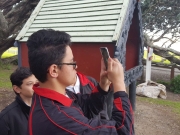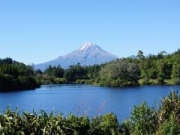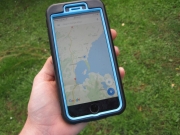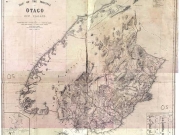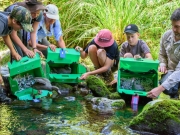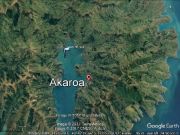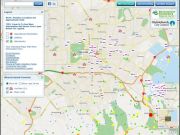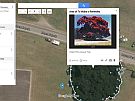All LEARNZ field trips targeting primary and secondary schools are closely linked to the New Zealand curriculum, in particular science, social studies and geography. They can also be used by other subject teachers.
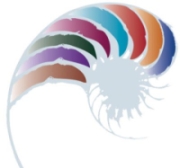
Key concepts
citizenship, community involvement, conservation, culture, DoC, environment, environmental education, future focus, GIS, GIS and iwi, identity, location based information, Māori, maps, monitoring change, native species, perspectives, population, recording, recreation, science, scientific research, sustainability, taonga, values
- Watch this video where Duan Wilkins talks with Chris Harwood from the Ministry of Education about how the Map My Waahi field trip aligns with the New Zealand curriculum. She also highlights some Tuia 250 resources that fit well within this field trip's themes.
The New Zealand Curriculum - NZC
Key Competencies
LEARNZ virtual field trips contribute to the development of all five key competencies:
| Key competencies | Examples of related field trip components |
| Thinking | Constructing questions to put to experts during Web conferences. |
| Using language, symbols and texts | Interpreting and making meaning of a variety of language and symbols in the Background Pages and throughout the web site. |
| Managing self | Numerous content-related Activities provide students with chances to engage with the material and create their own interpretation of the content. |
| Relating to others | Videos connect students with a range of expert opinions. Students listen actively when seeking answers to video questions. |
| Participating and contributing | LEARNZ Virtual Field Trips are an ideal medium for group-based topic inquiry. They also enable students to transfer new learning into the context of their own communities where they are encouraged to take action. |
(See page 12-13 NZC 2007)
Values
The Map my Waahi field trip encourages, models and explores these values:
- innovation, inquiry and curiosity
- ecological sustainability
- community and participation
(see page 10 NZC 2007).
E-learning and pedagogy
The Map my Waahi field trip directly involves learning that is supported by information and communication technology (ICT).
In particular, the trip will:
- Assist the making of connections by enabling students to enter and explore new learning environments, overcoming barriers of distance and time.
- Facilitate shared learning by enabling students to join or create communities of learners that extend well beyond the classroom.
- Enhance opportunities to learn by offering students virtual experiences and tools that save them time, allowing them to take their learning further (Page 36 NZC 2007).
Social Science
| Strand | Achievement Aims | Related background pages |
|
Place and Environment Identity, Culture and Organisation Continuity and Change |
Level 1: Understand how places in New Zealand are significant for individuals and groups | Understand how the past is important to people. Level 2: Understand how places influence people and people influence places | Understand that people have social, cultural, and economic roles, rights, and responsibilities. Level 3: Understand how groups make and implement rules | Understand how people view and use places differently. Level 4: Understand how people pass on and sustain culture and heritage for different reasons and that this has consequences for people | Understand how exploration and innovation create opportunities and challenges for people, places, and environments | Understand how people participate individually and collectively in response to community challenges. |
|
Technology
| Strand | Achievement Aims | Background Pages |
|
Technological Practice |
Brief development Level 2: Explain the outcome they are developing and describe the attributes it should have, taking account of the need or opportunity and the resources available. Level 3: Describe the nature of an intended outcome, explaining how it addresses the need or opportunity. Describe the key attributes that enable development and evaluation of an outcome. Level 4: Justify the nature of an intended outcome in relation to the need or opportunity. Describe the key attributes identified in stakeholder feedback, which will inform the development of an outcome and its evaluation. |
|
|
Technological Knowledge |
Technological products Level 2: Understand that there is a relationship between a material used and its performance properties in a technological product. Level 3: Understand the relationship between the materials used and their performance properties in technological products. Level 4: Understand that materials can be formed, manipulated, and/or transformed to enhance the fitness for purpose of a technological product. |
|
|
Nature of Technology |
Characteristics of technology Level 2: Understand that technology both reflects and changes society and the environment and increases people’s capability. Level 3: Understand how society and environments impact on and are influenced by technology in historical and contemporary contexts and that technological knowledge is validated by successful function. Level 4: Understand how technological development expands human possibilities and how technology draws on knowledge from a wide range of disciplines. |
Health and Physical Education
| Strand | Achievement Aims | Related Background Pages |
|
Healthy communities and environments - D |
D2 Community Resources Level 2: Identify and use local community resources and explain how these contribute to a healthy community. Level 3: Participate in communal events and describe how such events enhance the well-being of the community. Level 4: Investigate and/or access a range of community resources that support well-being and evaluate the contribution made by each to the well-being of community members. |
English
The selected processes and strategies indicators used in the table below are from Level three of the NZC, but aim to cover indicators from levels two to four.
| Strand | Processes and strategies indicators | Example of related field trip component |
|
Speaking, Writing and Presenting |
|
|
|
Listening, Reading and Viewing |
|
|

